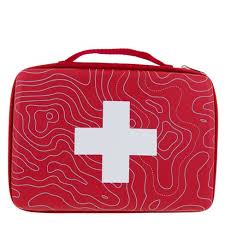The Facilitator’s First Aid Kit
Here’s something they don’t teach you in facilitation school: bring absolutely everything you and your participants need, even if it is something that may seem obvious, like pens.
I cannot tell you how many times I have asked participants, “Who needs a pen?” prior to doing a writing activity halfway through a workshop or meeting, only to find out that a number of them have spent the entire first half of the meeting without one.
Here’s my solution: make yourself the facilitator’s equivalent of a first aid kit! Here is what I have and recommend for the “kit” I bring to every engagement:
- Pens. For the reason just stated above. In fact, I buy a lot of pens and then let participants know they can keep them if they want to.
- Dry Erase Markers. There is often a whiteboard in the rooms I find myself in (classrooms, boardrooms, etc.), but there is almost never the markers to go with it. I greatly prefer using a whiteboard to chart paper, when possible, because it saves trees.
- Chart Paper Markers. I always ask if there is a whiteboard in the rooms I will be in. If the answer is “no” I make sure to have chart paper. The important thing here is to make sure you don’t use your chart paper markers, which are usually permanent, on a whiteboard, or your whiteboard markers, which will dry up quickly if used on paper, on the charts.
- Blue Tape. This is generally for hanging the chart paper, but can also be used to hang signs, or reinforce the stickiness of name tags or sticky notes that keep falling off.
- Blank Paper. This is for making signs. Sometimes I show up to a space and the room we are in is really hard to find. By the time participants have found the room, they are agitated, out of breath, and sometimes even late. A few well-placed arrows/signs can make a big difference in how much more calmly people show up.
- Blank Name Tags. I buy name tags in bulk and just keep them in my kit. It’s just one less thing I have to remember as I am packing up my other workshop or meeting materials.
- Sticky Notes. As with name tags, I use these a lot so I buy them in bulk and always keep them with me.
- Ibuprofen. The only thing worse than facilitating with a headache, is facilitating while one of your participants has a headache. I give away more ibuprofen than I use myself because it really cheers people up when you are able to offer them relief.
- A Phone Charger. Like the ibuprofen, I am more often loaning this to participants than using it myself. I labeled it, too, so that it finds its way back to me at the end of the event.
- PPT Connector. Similar to the phone charger and ibuprofen, since I don’t often use PPT, this is really for my colleagues, especially when I’m coordinating an event, although I try to remind people to bring all of their own cords and connectors.
- Thumb Drive. While most people house their documents, presentations, and videos online, it never fails that at some point the internet will not work well and these critical elements cannot be accessed. I encourage my colleagues to put everything they need onto a drive “just in case,” but because sometimes they don’t listen, I bring one so they can transfer materials from their personal computers to the venue computers if the internet isn’t working properly.
- A Large Clip-on Flower. Because I coordinate and host a lot of events, having an identifier on me can help participants who need help find me in a crowd. I let everyone who is helping with the event know that if someone runs into a problem or has a questions, they should look for the “woman with the bright orange flower in her hair.”
Of course, you can also put all of the other “essential” items that you would put into any other emergency-type kit into your bag, particularly if you will be facilitating in different locations each day, which is usually true for me. Those things might include feminine products, tissues, needle and thread, earplugs, water bottle, etc. You may find yourself often sharing these things rather than using them yourself, but as a Transformational Facilitator, being prepared to meet participants needs doesn’t always just mean having a tight agenda.
Good luck building your kit! Let me know if I left anything out.
